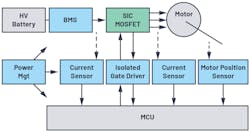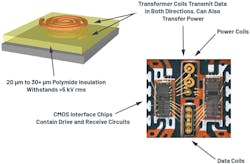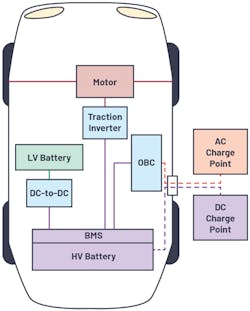Delivering on the EV Range Promise of SiC-Based Traction Inverters
Members can download this article in PDF format.
What you'll learn:
- Why SiC power switches in traction inverters are considered the linchpins to helping expand EV range.
- The crucial role gate drivers play in SiC power switches.
- Optimizing EV drivetrain power efficiencies by neutralizing EMI in surrounding componentry.
Two major disruptions are currently affecting the future of vehicular transport and semiconductor technology. We’re embracing a new and exciting means to propel our vehicles cleanly with electrical power, while simultaneously reengineering the semiconductor materials that underpin electric-vehicle (EV) subsystems to maximize power efficiency and, in turn, EV driving range.
Government regulators continue to mandate that automotive OEMs reduce the overall CO2 emissions of their vehicle fleets, with stringent penalties for noncompliance, and EV charging infrastructure is beginning to proliferate alongside our roadways and parking areas. For all these advances, though, mainstream consumer adoption of EVs remains stunted by lingering concerns over EV range limitations.
Complicating matters, the larger EV battery sizes that could extend EV range and neutralize consumers’ range anxiety threaten to simultaneously increase EV prices. The battery accounts for more than 25% of the final vehicle cost.
Fortunately, the semiconductor revolution occurring in parallel has yielded new wide-bandgap (WBG) devices such as silicon-carbide (SiC) MOSFET power switches. They can help shrink the gap between consumers’ EV range expectations and OEMs’ ability to satisfy them at competitive cost structures.
Getting the Most from SiC Technology
The inherent benefits of SiC-based power switches in terms of power density and efficiency are well understood, with key implications for system cooling and size. The evolution to SiC promises 3X smaller inverters at 800 V/250 kW, with additional significant size and cost savings on companion dc link film capacitors. Compared to conventional silicon, SiC power switches can enable better range and/or a reduced battery pack, giving the switches a favorable cost comparison from the device level to the system level.
At the intersection of these range and cost considerations, the traction inverter remains at the epicenter for innovations aimed at unlocking further EV efficiency and range gains. And as the most expensive and functionally important element of the traction inverter, SiC power switches need to be controlled very accurately to realize the full benefit of the extra switch cost.
Indeed, all of the intrinsic advantages of the SiC switch would be negated by common-mode noise perturbations, as well as extremely high and destructive voltage overshoot due to ultra-fast voltage and current transients (dv/dt and di/dt) generated in a poorly managed power switch’s environment. Broadly speaking, the SiC switch has a relatively simple function despite the underlying technology—it’s only a 3-terminal device—but it must be carefully interfaced to the systems.
Enter the Gate Driver
The isolated gate driver will take care of setting the best switching sweet spot, ensuring short and accurate propagation delay through the isolation barrier. It also provides system and safety isolation, controls power switch overheating, detects and protects against short circuits, and facilitates the insertion of the sub-block drive/switch function in an ASIL D system.
However, the high slew-rate transients introduced by the SiC switch can corrupt data transmission across the isolation barrier. Thus, measuring and understanding the susceptibility to these transients is critical. On this front, iCoupler proprietary technology developed by Analog Devices (ADI) has shown leading common-mode transient immunity (CMTI) with measured performances up to 200 V/ns and beyond. This unlocks the full potential of SiC switching time under safe operation.
High-performance gate drivers have proven their value in real-world testing with leading SiC MOSFET power switch providers like Wolfspeed. Across key parameters, including short-circuit detection time and total fault clearance time, performance can be achieved down to 300 ns and 800 ns, respectively. For additional safety and protection, test results have demonstrated the adjustable soft-shutdown capabilities essential for smooth system operations.
Switching energy and electromagnetic compatibility (EMC) can likewise be maximized for improved power performance and EV range. Higher drive capability allows users to have faster edge rates and therefore reduces switching losses. This not only helps with efficiency, but also saves board space and cost by eliminating the need for external buffers allocated per gate driver.
Conversely, under certain conditions, the system may need to switch more slowly to achieve optimal efficiency, or even in stages, which studies have shown can further increase efficiency. ADI provides an adjustable slew rate so that users can achieve this goal, and the removal of external buffers eliminates further obstacles.
Elements in a System
It’s important to note that the combined value and performance of the gate driver and SiC switch solution can be completely negated by compromises and/or inefficiencies in surrounding components.
A holistic view of the EV reveals additional opportunities for optimizing drivetrain power efficiencies, which are critical for exploiting the maximum usable battery capacity while ensuring safe and reliable operations. The quality of the battery-management system (BMS) directly impacts the miles per charge an EV can deliver, maximizes the battery’s overall lifetime, and, as a result, lowers the total cost of ownership (TCO).
In terms of power management, the ability to overcome complex electromagnetic-interference (EMI) challenges—without compromising BOM costs or PCB footprint—becomes paramount. Power efficiency, thermal performance, and packaging remain critical considerations at the power-supply layer, regardless of whether the layer is for an isolated gate-driver power-supply circuit or auxiliary high-voltage-to-low-voltage dc-to-dc circuit.
In all cases, the ability to neutralize EMI issues takes on greater importance for EV designers. EMC is a critical pain point when it comes to switching for multiple power supplies. Superior EMC can go a long way toward shortening testing cycles and reducing design complexities, thereby accelerating time to market.
Deeper into the ecosystem of supporting componentry, advances in magnetics sensing have yielded a new generation of contactless current sensors delivering no power loss with high bandwidth and accuracy, as well as accurate and robust position sensors for end-of-shaft and off-shaft configurations. Between 15 and 30 current sensors are targeted for deployment in a typical plug-in hybrid EV,1 with rotation and position sensors monitoring traction motor functions. Sensing accuracy and robustness to the stray field are critical attributes for measuring and maintaining efficiencies across EV power subsystems.
End-to-End Efficiency
Looking holistically at all elements in the EV powertrain—from the battery to the traction inverter to the supporting components and beyond—ADI sees myriad opportunities to improve EVs in a manner that enhances overall power efficiency and extends driving range. Digital isolation is one of the many important parts of the equation as SiC power switching technology penetrates the EV traction inverter.
Likewise, automotive OEMs can leverage a multidisciplined approach to EV optimization to help ensure that all available power-monitoring and control devices work in close concert for maximum performance and efficiency. In turn, they can help overcome the last remaining barriers to mainstream consumer EV adoption—vehicle driving range and cost—while helping to ensure a greener future for all.
References
1. Richard Dixon. “MEMS Sensors for the Car of the Future.” 4th Annual Automotive Sensors and Electronics Summit, February 2019.





